Hyper Thinker #1
Rodin's iconic sculpture The Thinker, was first conceived in the late 19C. But what is The Thinker thinking NOW? How would a 21st Century Thinker look, feel and think like?
Frederik de Wilde's 3D sculpture of a man - this time with an augmented brain – is inspired by Rodin's work and asks: what is the impact of technology and automation in our society, on the role of philosophy and ethics? Through the use of a signal blocker, it forces you to be digitally disconnected. The HyperThinker #1 may trigger thoughts of those who live without the internet. How fair is that?
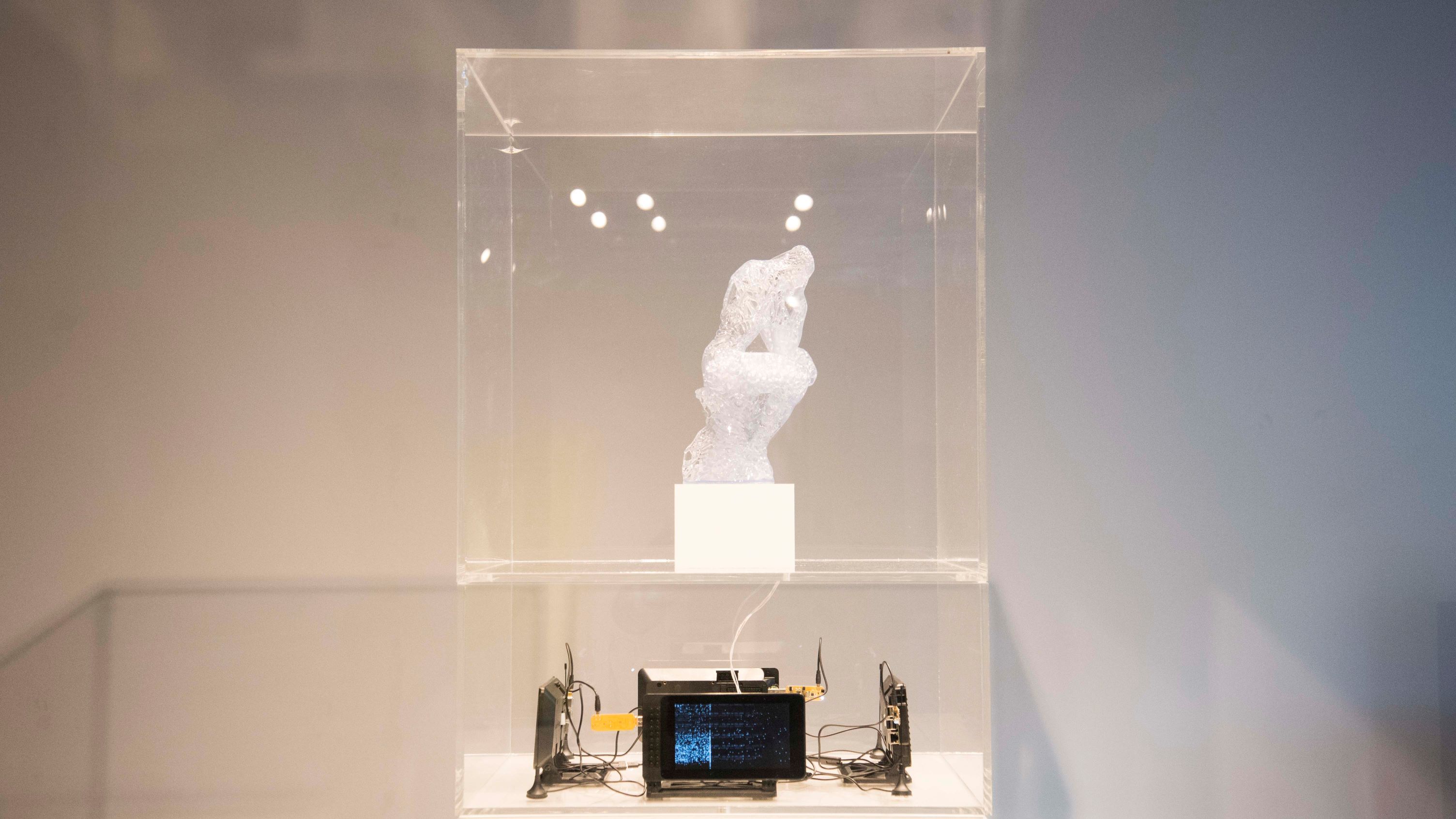
Hyper Thinker #1, F. De Wilde, 2017.
Artwork by Frederik De Wilde in collaboration with the philosopher Nicole Dewandre.
More about the work on the artist’s website.
What's your dream?
A set of photographic images taken from a school almost totally destroyed by the super-typhoon Haiyan in 2013 (the most destructive in the history of the Philippines, it left more than 6,000 people dead, 28,000 wounded, and devastated entire communities).
Yet, in Tacloban a school's chalkboard survived intact, unmoved and unshaken. Fabio Cian joined the International Disaster Volunteers and with questions about disasters and their impacts in relation to climate change, he used the chalkboard as a backdrop for survivors to answer the question 'What is your dream'?'.
To Cian, the eyes and dreams of the young survivors constitute the human species, which is just one of the millions sharing a place on this planet. Understanding this trajectory – that there are different realities, but with common origins - is what fairness means to him. Our dream is putting these together.
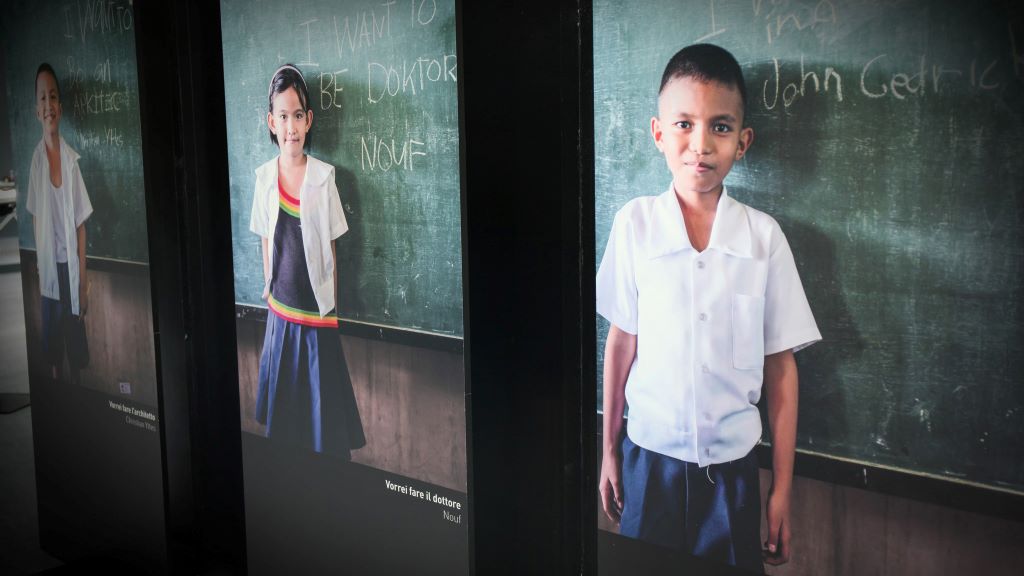
What's your dream?, 2017, F. Cian.
The Next Economy
How can the use of words become a form of critical and global resistance within society against what is perceived as what is right or wrong within the sphere of human behaviour and to the global commons?
And how far is our language for emotions determined by the market and market forces?
Inspired by a diagram representing the global unequal distribution, The Next Economy is an interactive steel and paper installation which focuses on the fact that human society, following a gradual yet profound transformation, has finally become driven and controlled by the markets.
Do you agree?
The artwork is a set of algorithms, designed in order to exchange economic terms with emotional words. Combined with poetry writing, but based on financial data obtained by a constant reading of International markets.

The Next Economy, 2017, F. Lattanzi Antinori.
Artwork by Fabio Lattanzi Antinori in collaboration with the economist Graziano Ceddia.
Fabio Lattanzi Antinori website.
Market of Externalities
From a distance, the dining table is perfectly set. Upon closer inspection you will see that objects placed on the table are filled with strange powders, liquids and even with dirty water. But what are these strange substances, and how - if at all – do they relate to sustainability and what ARE the full costs of food production?
In a series of short videos, the artists present their ideas, in the context of food production, of social sustainability, of inequality, of poverty, of fairness. Should we say that sustainability is an issue of fairness?
So, what do you eat?
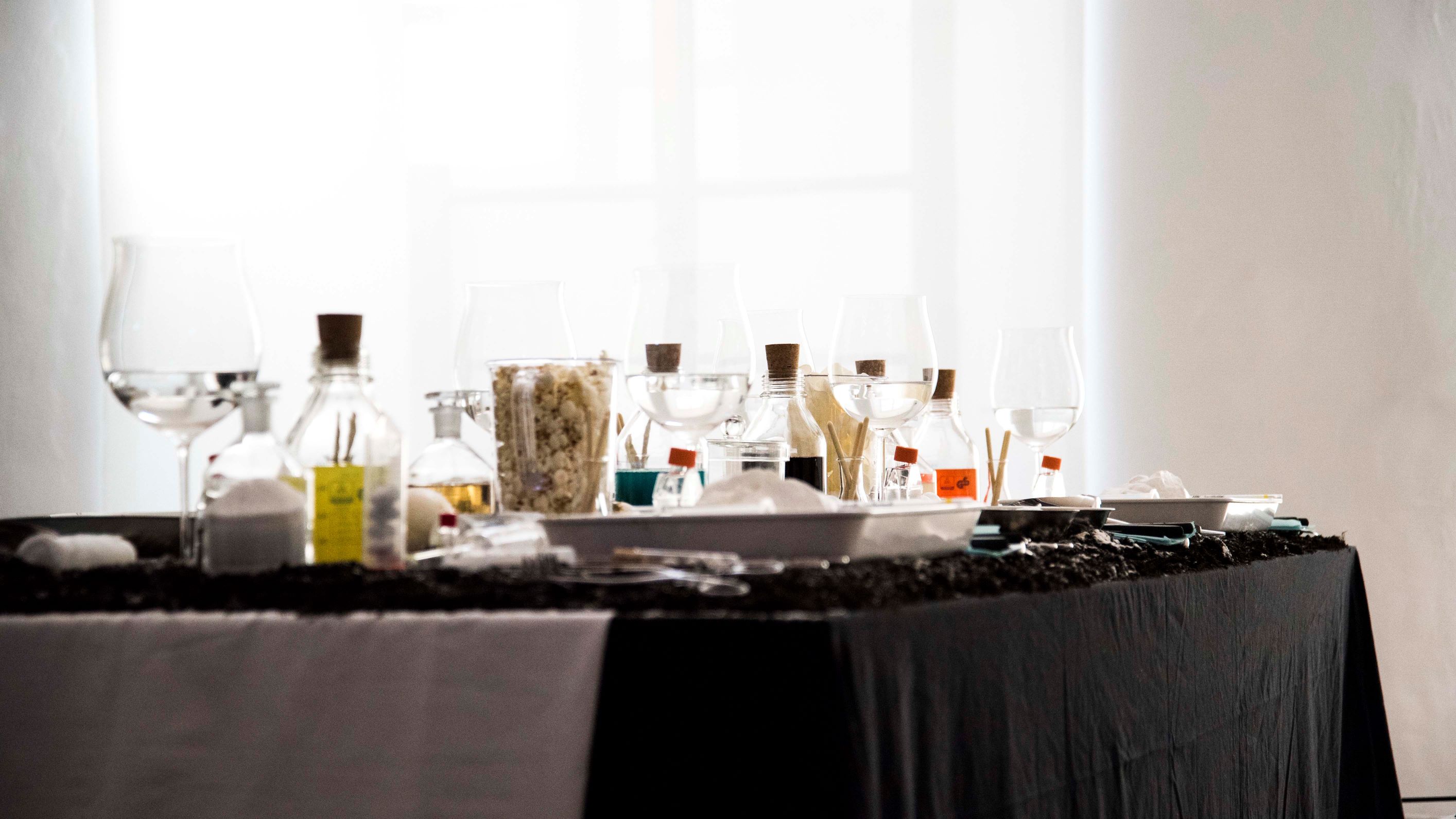
Market of Externalities, 2017, Honey & Bunny.
Artwork by Honey & Bunny in collaboration with Michela Secchi.
Honey & Bunny website.
More about the work on the artists' website.
The Water we Eat
Researchers on climate change and environmental sciences moved into photography with this installation which represents how we – humans – might achieve global water, food and energy security in a sustainable way.
Photographic images and visual data explore global trends in food consumption behaviour, and the amount of water required to produce our food. Take a look at these pictures: how many litres of water does it take to provide you with the foods you choose to eat?
Would you be encouraged to eat differently after seeing real-life dimensions for the water volume, which represent your daily diet choices? And if you see the enormous differences between the water needed in different countries?
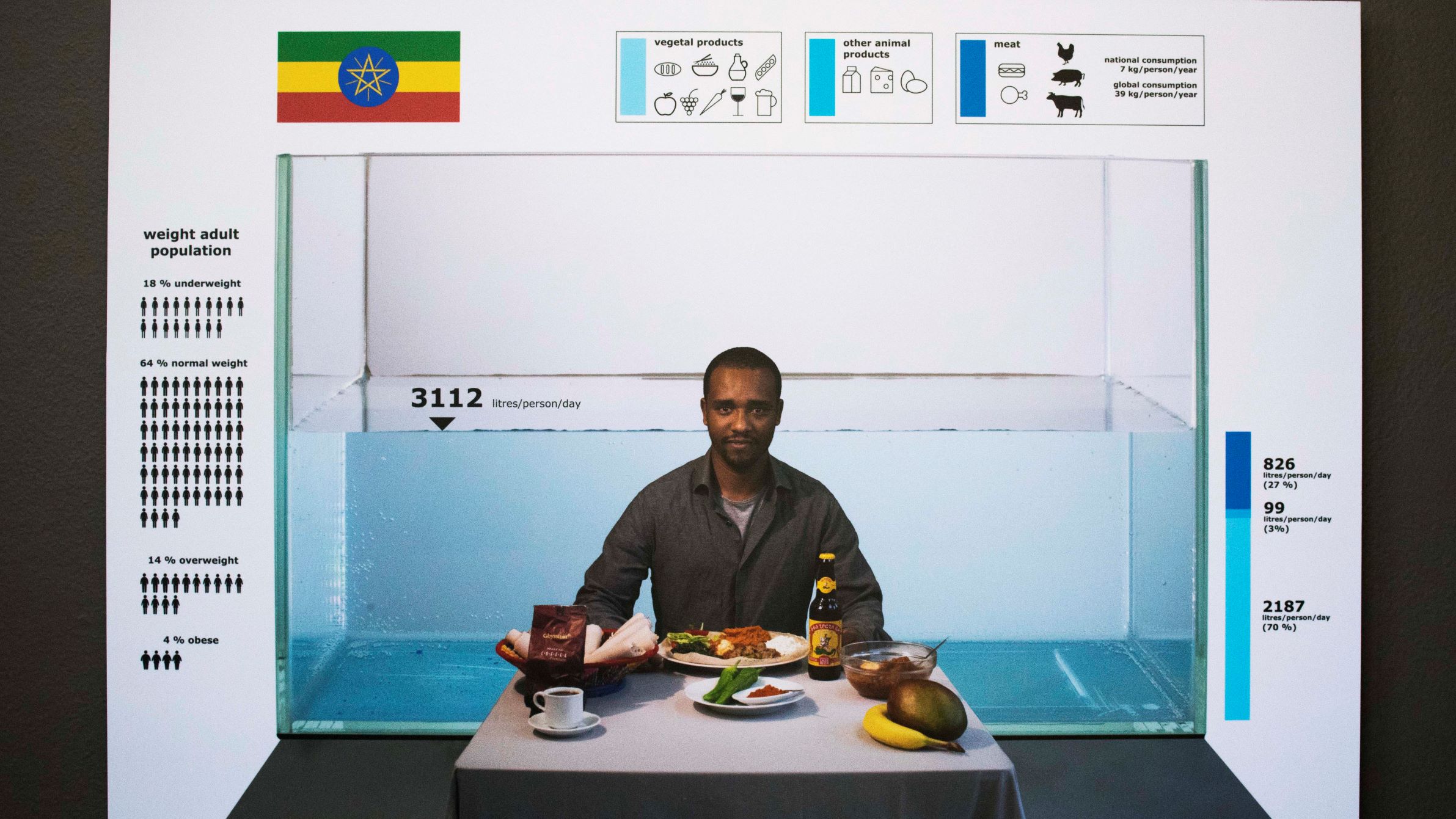
The Water we Eat, 2017, D. Vanham & L. Feyen.
Artwork by Davy Vanham & Luc Feyen.
A Particular Matter
From the upper stratosphere to cells inside our bodies, natural and polluted particles travel over the globe. This project, in the form of an installation of interwoven narratives and journeys on the trail of a meteor, invites the visitors to reflect upon our mode of existence, our sense of common good and fairness today.
The story began on one of the most northerly of the Scottish isles, on the remote reef of Fair Isle. Travelling back to the point it was emitted from: the exhaust pipe of a ship in the English Channel, at the southern edge of the North Downs. The precise itinerary of this particle could be retraced by means of atmospheric backward trajectory models and of the analyses of anthropogenic emission of air pollutants that the European Commission makes every day.
Equipment on the expedition was composed of helmets with a little camera, through which each day’s journey was crystallised in a photograph with a unique point of view: that of the skyline. The walking outfit with breathing masks and filters trapped the black carbon particles we encountered. These particles were later extracted by JRC scientist Jean-Philippe Putaud and turned into ink.
The photographs visible in the installation are partially composed of that ink made from the particles.
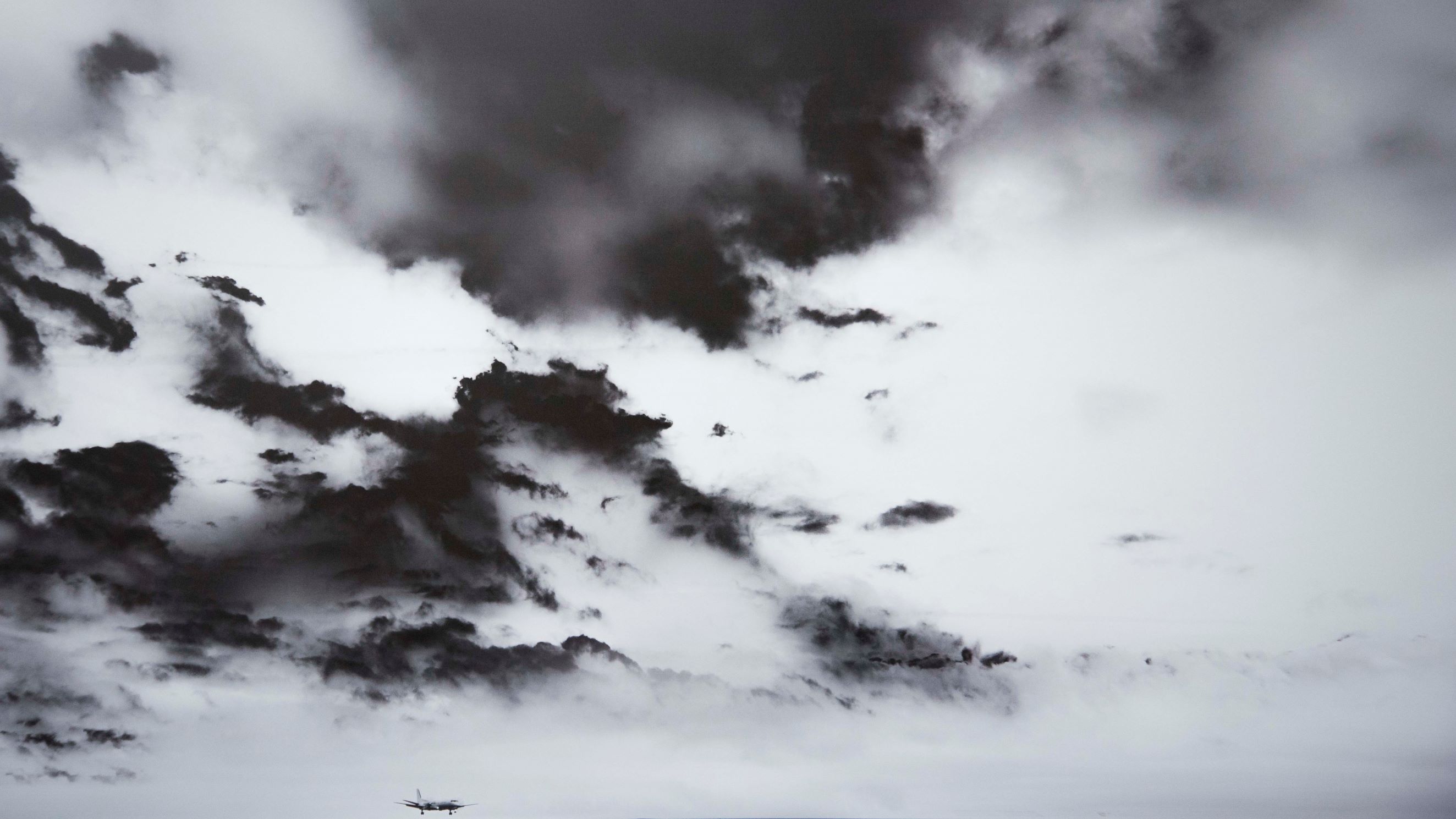
A Particular Matter, 2017, A. Tondeur.
Artwork by Anaïs Tondeur with Rita Van Dingenen and Jean-Philippe Putaud.
Anaïs Tondeur website.
More on the work on the artist's website.
The Grand Scientific and Social Exhibition
The Greatest Show on Earth - The Grand Scientific and Social Exhibition is an installation inspired by the “Grand Traveling Museum, Menagerie, Caravan & Hippodrome” of P.T. Barnum, who used to say “we’ve got something for everyone”.
Part of Barnum’s caravan was a “human zoo”, which showed, locked behind bars, human beings considered dangerous or exceptional. The so-called “Barnum effect” is the phenomenon whereby individuals, confronted with a general psychological profile that supposedly refers to them, tend to recognise themselves in it and consider it precise and accurate, without realising that the profile is vague and generic, written specifically to appeal to a wide range of people.
Which history of Europe do we want to tell today?
This work is an investigation of our fears and of the historical moment that Europe is going through, characterised by great uncertainties and great waves of migrants. Using a metaphor – the construction of a traveling circus – the installation tries to draw a portrait of our society, underlining its inconsistencies and confronting the spectator with his own fears and doubts.
The work is divided in three parts:
- The Wagon Cage: an installation of a cart with bars, based on models used at the end of the 1800s and the beginning of the 1900s.
- The Burqarium: a cart with two glass display cases confronting each other. In the first display case, a woman wearing a burqa (or a niqab). In the display case in front of her, a woman that seems naked.
- The Incredible Human Cannonball: a cannon like the ones used to shoot out humans. At fixed hours of the day, the human cannonball will arrive and, after a short speech, will be shot to the stars.
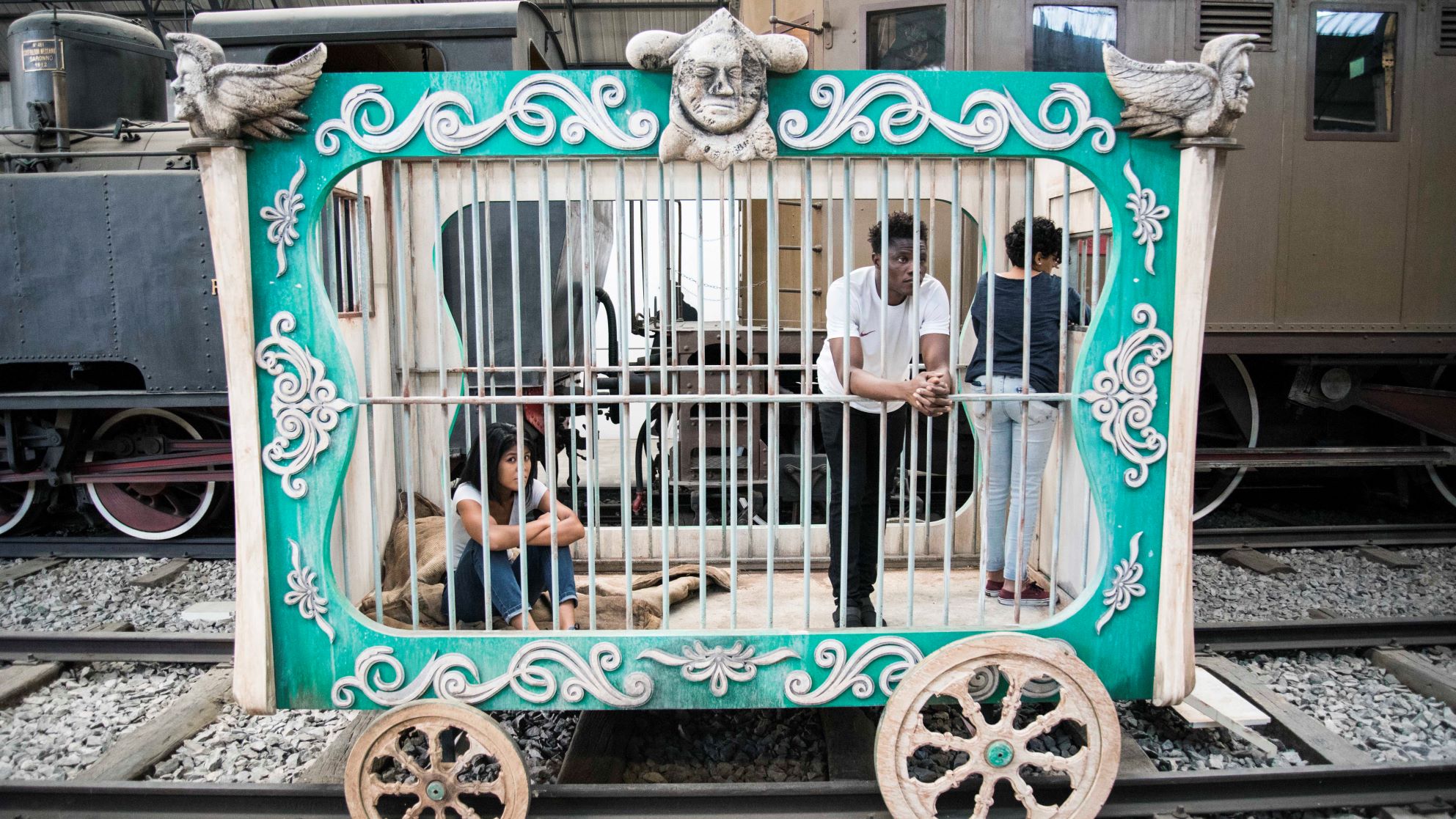
The Grand Scientific and Social Exhibition, 2017, L. Montanini.
Artwork by Lorenzo Montanini in collaboration with Daniela Ghio.
Lorenzo Montanini website.
More on the work on the artist's website.
Radio Frankenstein
The Radio Frankenstein project is a modern-stage adaptation of the famous novel. In this adaptation, the play is revised to incorporate novel technological developments, in particular the recent advances seen in 3D printing and bio-printing of human tissues and organs.
The action revolves around the potentials of human tissue growth, 3D and bio-printing, manipulation of human genome, transplants of important organs and central body parts, and resulting debates on human enhancement and transhumanism.
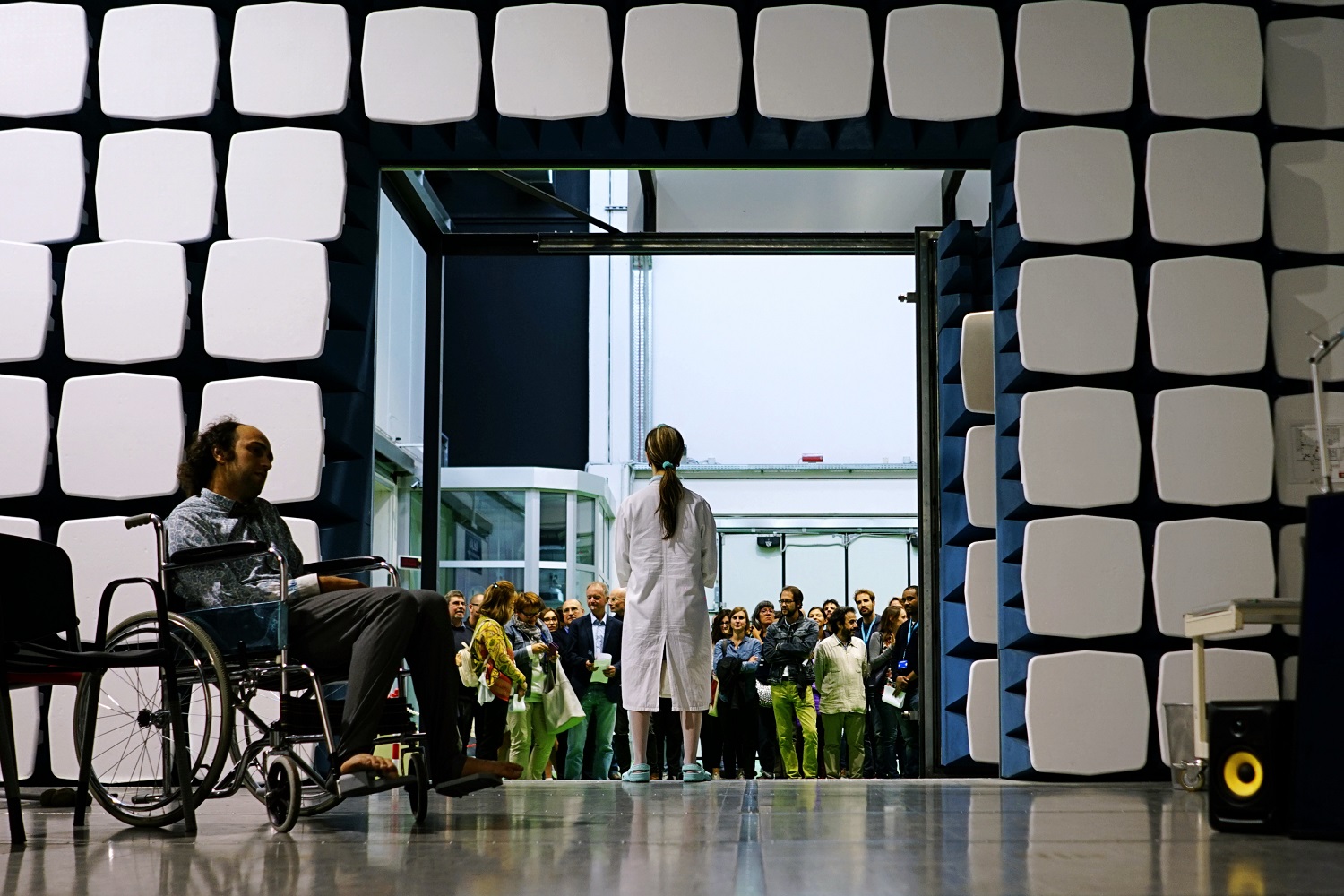
Radio Frankenstein, 2017, Markus Zohner.
Performance developed by Markus Zohner in collaboration with philosopher Nicole Dewandre and media specialist Paulo Rosa.
Markus Zohner website.
More on the work on the artist's website.
La Fabbrica dei Terremoti
This photographic installation magnifies how humans are intrinsically part of the global loops of the earth’s retroaction and its atmospheric, biological, geological or oceanic cycles.
As natural phenomena manifest themselves in an increasingly violent way, the photographs from La Fabbrica dei Terremoti urge us to rethink the incrementing inequalities, which affect the most vulnerable of us. Human tragedies are incrementally entangled into the systemic folds of the planetary disturbance, putting at risk the poorest population and the most deprived territories.
The seismographic images show the unique waveforms of earthquakes. Simulating particular earthquakes in a receptacle filled with water makes the frenetic movement induced by an earthquake visible to the human eye.
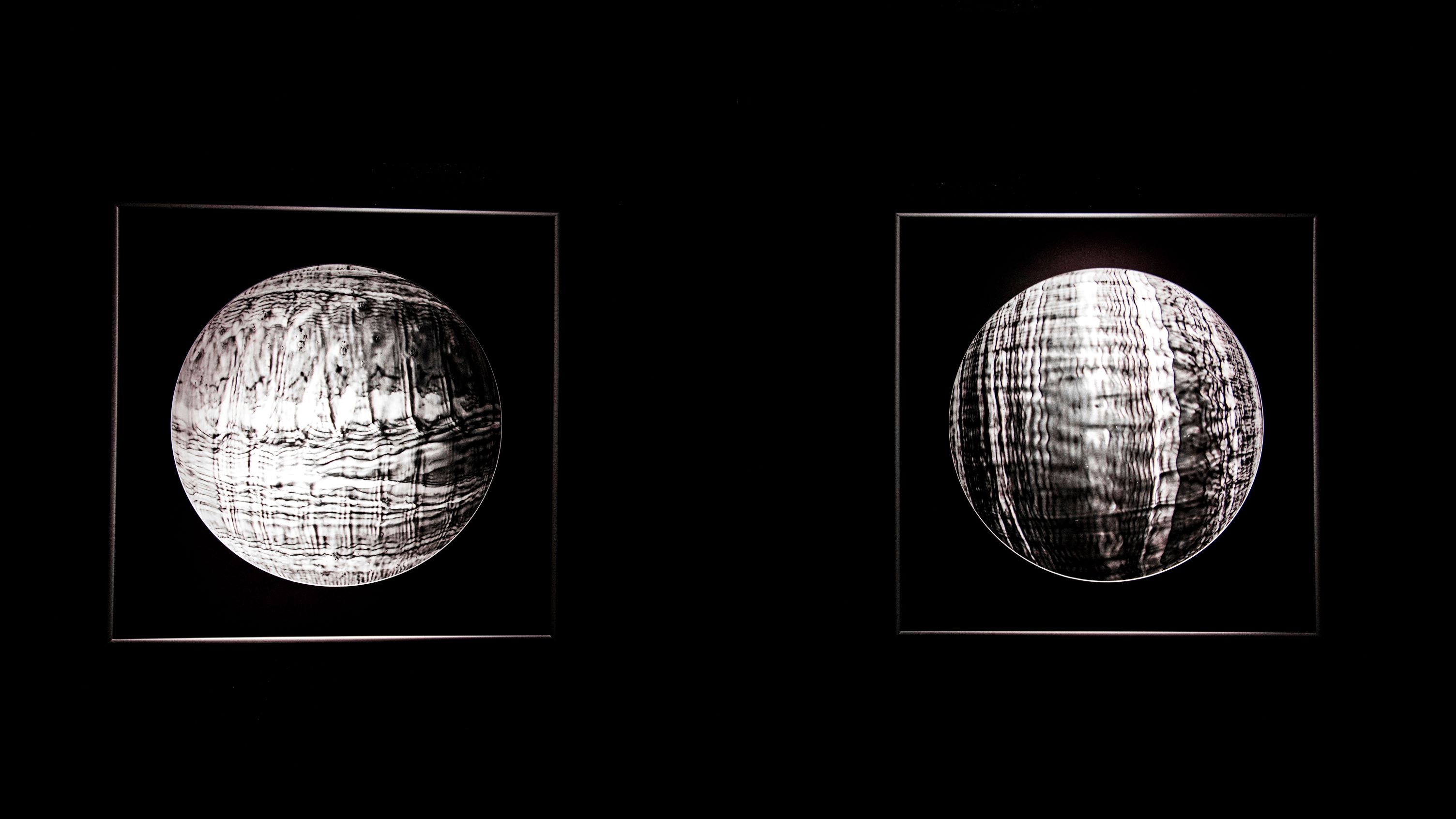
La Fabbrica dei Terremoti, 2017, Anaïs Tondeur.
Artwork by Anaïs Tondeur in collaboration with Geologist Francesco Mugnai.
Anaïs Tondeur website.
More on the work on the artist's website.
Mickey Morph
This preparation for a bio-art sculpture explores the relationship between nature, technology and cultural diversity against the backdrop of "disneyfication". Thanks to computer technologies, software and hardware (eg. 3D printing of biomaterials), we can generate and print organic materials, and who knows, succeed in creating new types in the lab.
Mickey Morph also refers to the – sometimes – necessary testing on animals, to the animal suffering in the laboratories, to the legal framework around it, the ethical awareness supported by many scientists to do something about it.
That is Mickey Morph's dream: mapping these ethical questions and experiments, at the intersection of art and science, transforming and mutating them into something that confronts us with ourselves and the society we live in and are evolving into.
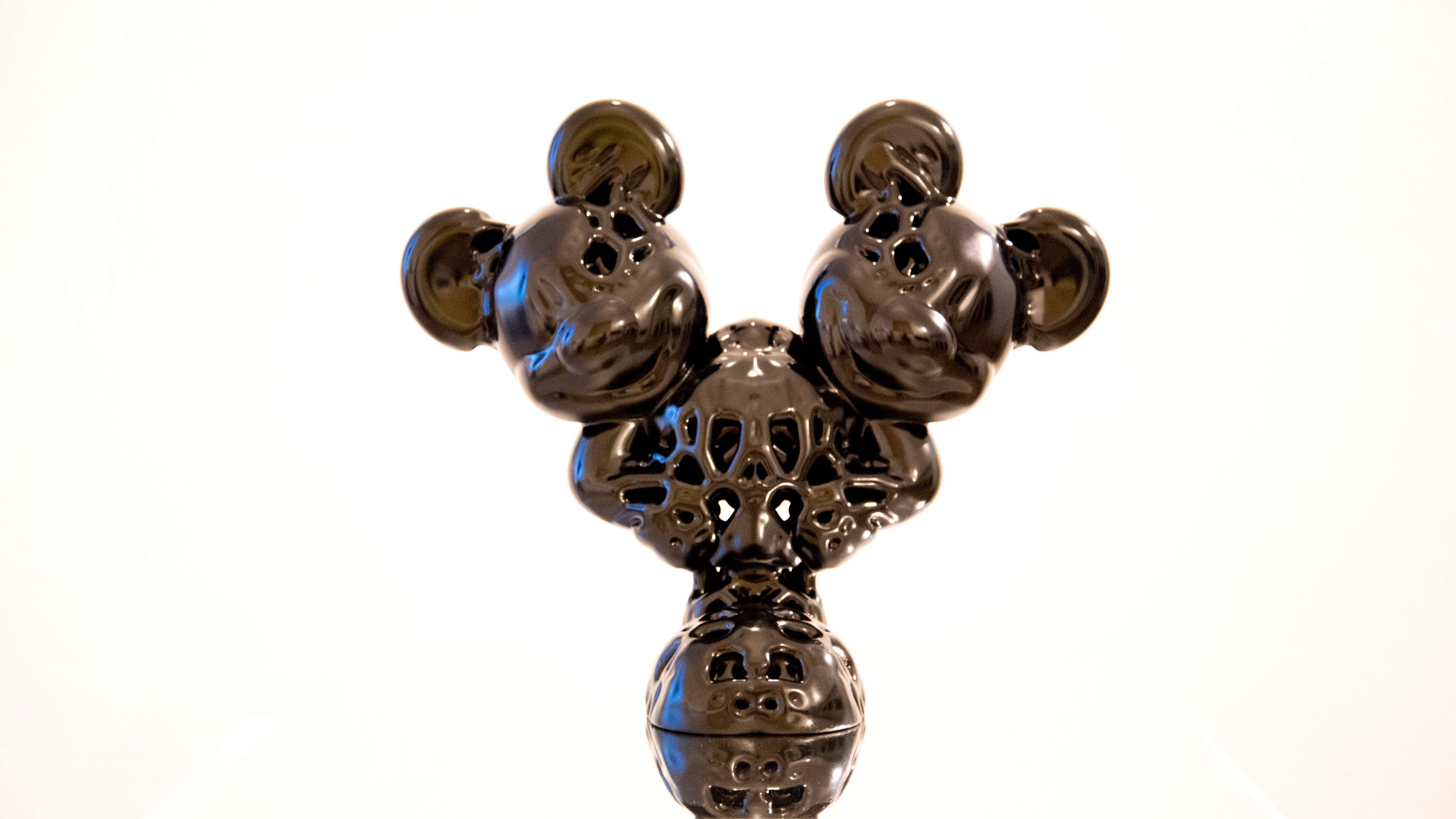
Mickey Morph, 2017, F. De Wilde.
Artwork by Frederik De Wilde in collaboration with Laura Gribaldo.
More about the work on the artist’s website.
Sensorial Skin for an Intelligent Guerilla Beehive
Inspired by the intelligence, complexity and self-organisation of bee colonies, the Sensorial Skin for an Intelligent Guerilla Beehive is a bio installation (i.e. a sculpture constructed from organic materials and using open source digital fabrication methods such as 3D printing) which provides viewers an artistic, visual and audio experience of activities in and around a beehive.
Bees are bio-indicators. They reflect the health of their surrounding ecosystem as well as the cumulative effects of different pollutants. Pesticides, parasites, air pollution and the compromised state of the bees’ foraging fields are among the main factors threatening bee colonies.
To tackle this, the artist has created a radically new beehive: the Intelligent Guerilla Beehive. Could bees survive in an urban environment using the innovative artistic techniques and scientific data on biotechnology? Look at the biofilm on the upper cellulose skin. It acts as a biosensor, changing colour and making patterns that reflect environmental threats such as pollution.
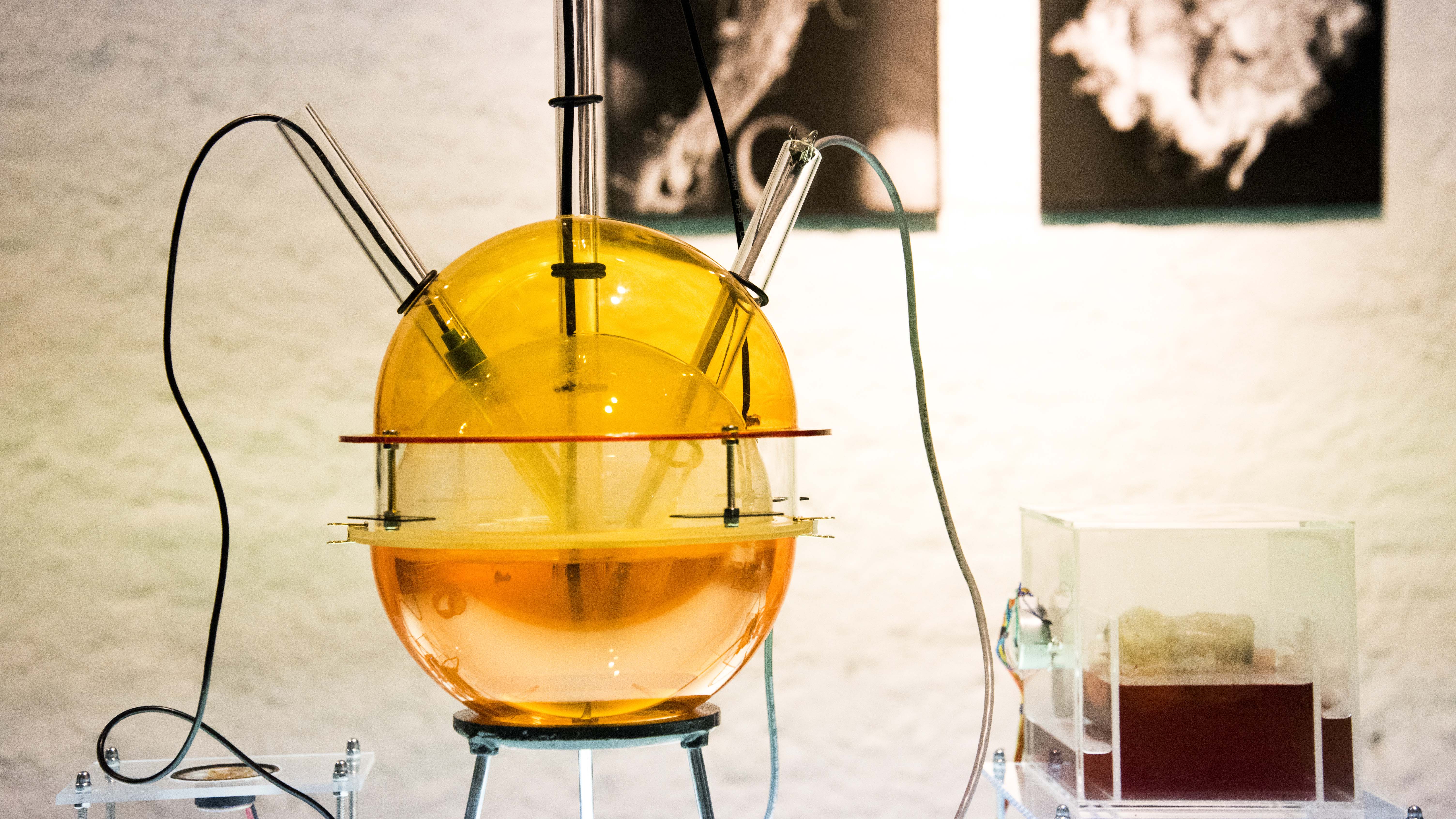
Sensorial Skin for an Intelligent Guerilla Beehive, 2017, A. Maes.
Artwork by Anne Marie Maes in collaboration with Biocomputationist Núria Condé Pueyo, toxicologist Laura Gribaldo and media specialist Paulo Rosa.
Anne Marie Maes website.
More about the work on the artist's website.
The Sebastiano Experience
What does an earthquake look like and how does it sound?
A multi-sensory experience on natural hazards and the theme of (un)fairness, with the aim of teaching school children how to behave in case of disasters, what is the basic knowledge that enables humans to tackle such catastrophic events?
The Sebastiano Experience translates the songs of the show Sebastiano all’Opera (presented in the Opera of the Maggio Fiorentino in November 2015) into an event treating the same themes of the musical, ow we might confront natural disasters in an intelligent way.
Using data from historical catastrophes, including their frequency and characteristic wave-forms (transmitted energies, lengths, modulations and resonance) a background sound is generated which represents the rhythm of nature and the simple existence of humans. The visitor is confronted with a vibrant body of light and sound that immerses him in the experience of an earthquake.
What questions does it raise about the relationship between the environmental events and humanity?
Is there a way to coexist with catastrophe?
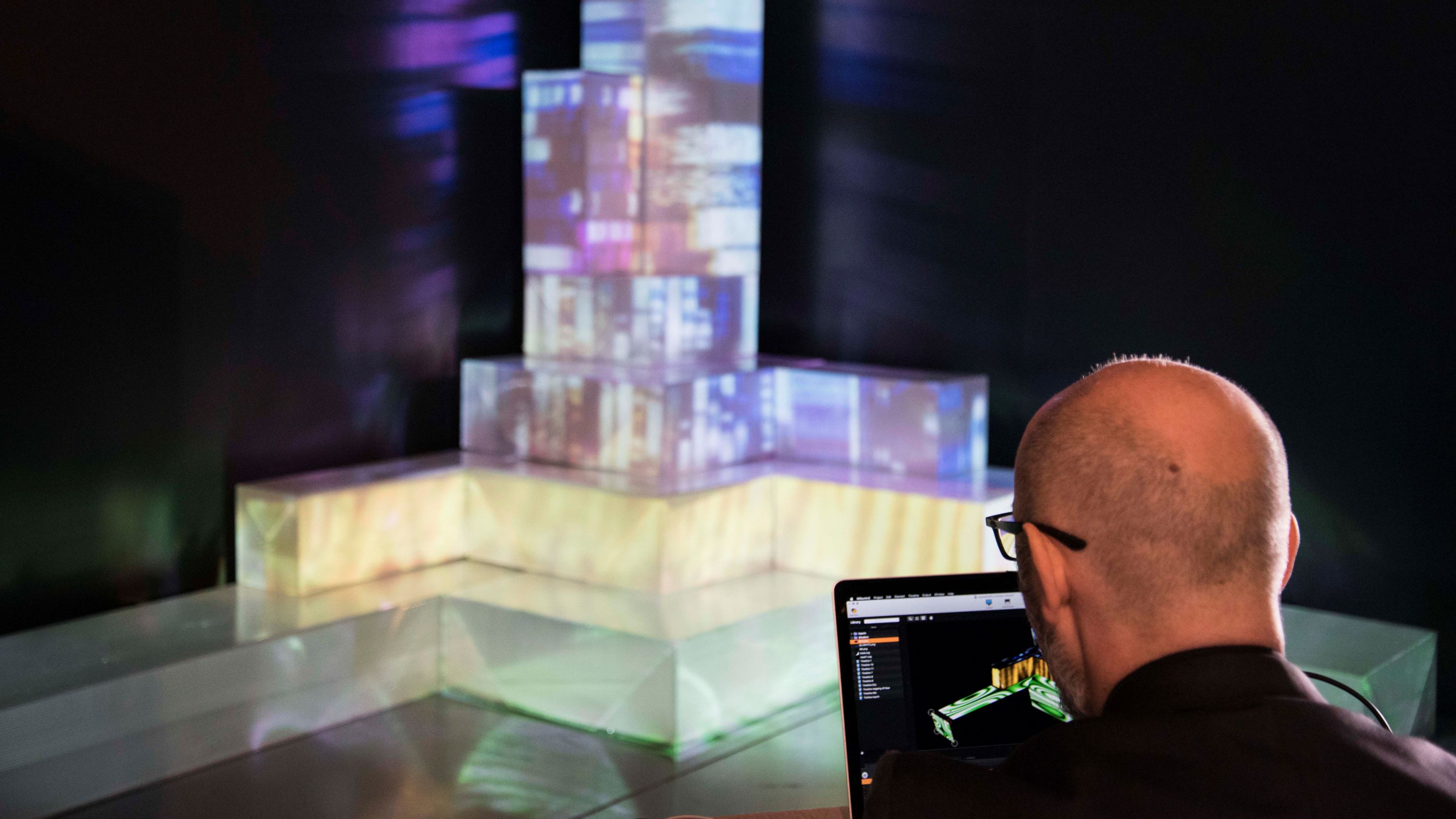
The Sebastiano Experience, 2017, M. Costanzi and C. Fiorini.
Artwork by Mario Costanzi and Carlo Fiorini, in collaboration with geologist Francesco Mugnai.
Oscillum
Imagine yourself in an ancient Roman olive grove in Puglia, what are these strange discs transmitting sound, hanging on the branches?
Imagine the disks are inspired by an ancient Messapian custom, hung up on a tree in order to foretell and protect the fertility of vines and olive tree fields.
The Oscillum is the protagonist of the installation. It faces different aspects of the subject and talks about a territory that was left unchanged for centuries and that is now being subject to a massive destructive transformation. Take the modern context where the disks denounce the increasing occurrence of the bacterium Xylella, which did not naturally occur in Europe, causing the drying up of olive trees and eventually their death.
Immerse yourself in this interactive installation which encourages reflection on how art and science can work together and on the role of technology in our society. Technical data provided by the Laboratory for Monitoring Stress in Trees using Environment Remote Sensing (or "Monsters") is converted into digital sounds.
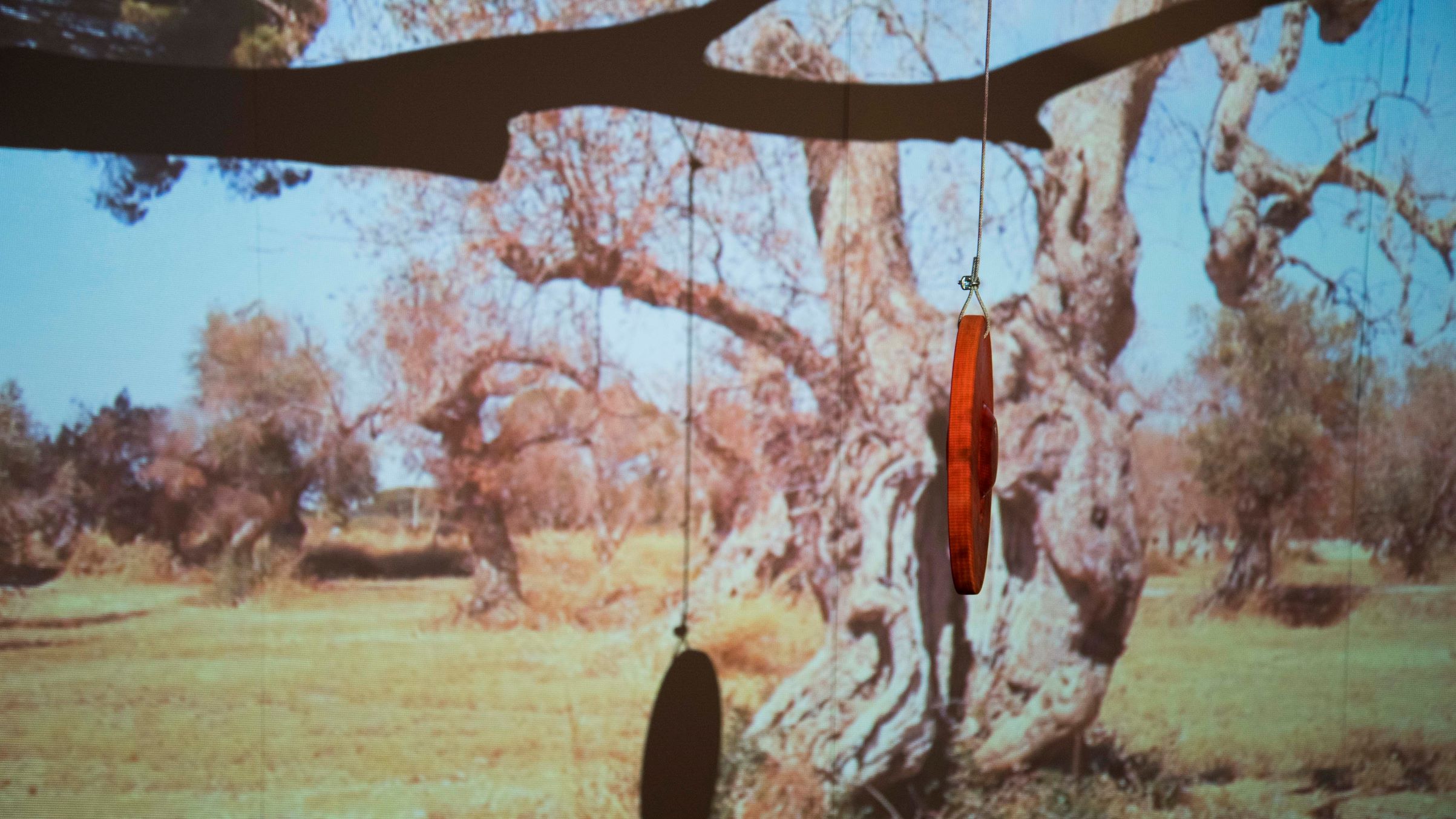
Artwork by Matteo Pizzolante in collaboration with Pieter Beck.
Matteo Pizzolante website.
More information about the work on the artist's website.
Double Ocean
When we are unfair to nature, it is very often because we simply do not understand it. Shall we ever be able to grasp the complexity of our climate, of this whirling blue ball that is the Earth? Or is it simply beyond our grasp to understand her staggering complexity?
If it is, we might be doomed to always harm other living beings or the lifeless surroundings they live in. Can we stop activities that will provoke as much harm as an earthquake? Can we even think of fairness if we look at the earth always from our point of view, as if the other living beings and the nature they live in didn't exist? Can we even be fair?
We put sculpture and SciArt together to capture the world's incessant motion and fluidity. Kim De Ruysscher's marble sculpture breathes a feeling of stillness, a frozen memory of the ocean fixed in stone. Evelina Domnitch and Dmitry Gelfand create flows of water over this stillness, evoking the enormous power of the Earth's axial rotation. A double ocean, one in stone, one in flowing water.
The sculptor as translator, who raises the unknown to the known, can show us rich lodes of stones and rock that live. He can show us the traces of the past that contain surprising messages for the present or the future. With the experiment of sculpture combining with SciArt, the sculpture wants to uncover the ancient fluidity of the stone with the possibilities of modern science. It evokes the swirling of air and clouds in our atmosphere.
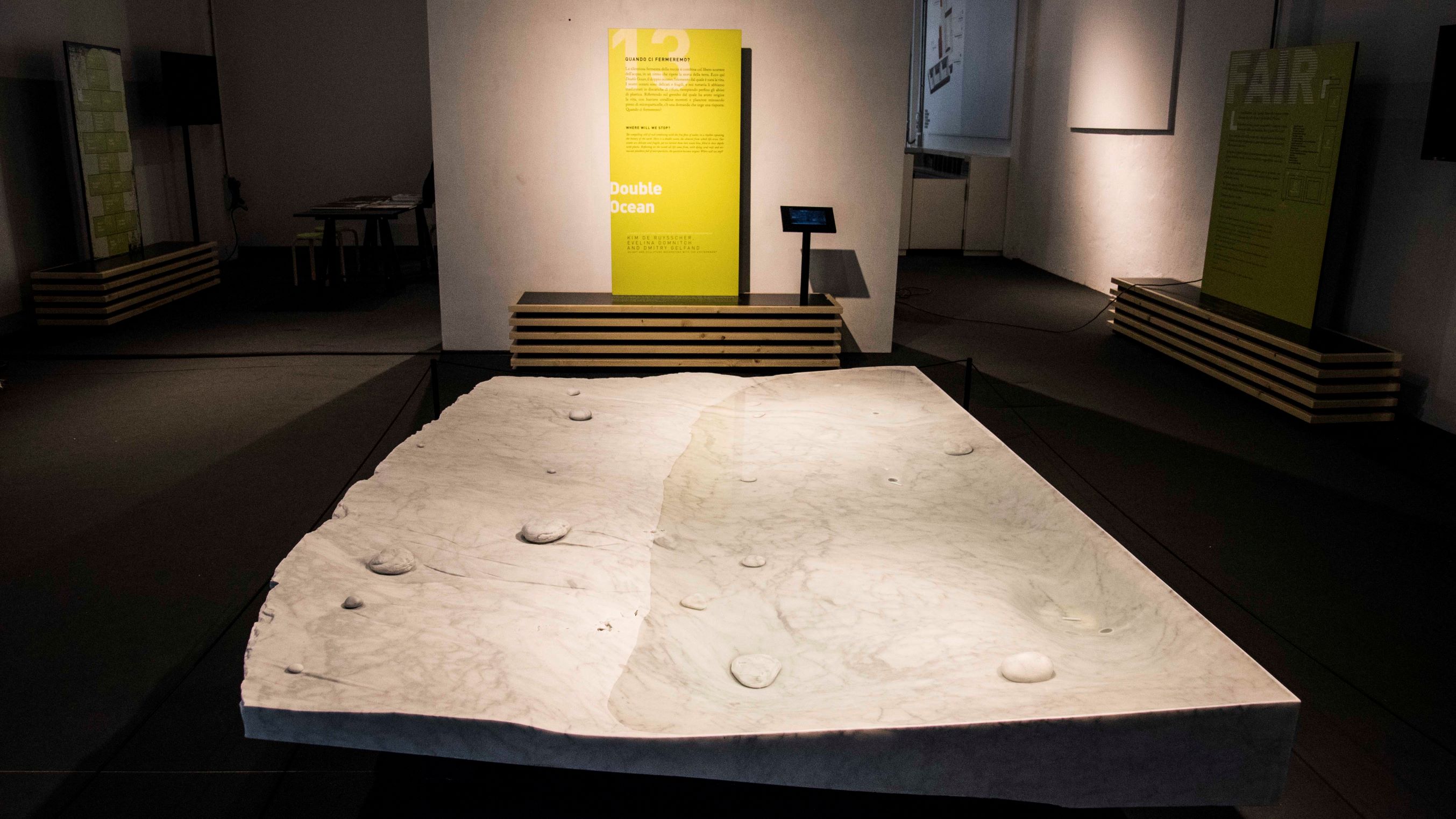
Double Ocean, 2017, Artwork by K. De Ruysscher, E. Domnitch and D. Gelfand.
SciArt and sculpture artwork by Kim De Ruysscher, Evelina Domnitch and Dmitry Gelfand.
Kim De Ruysscher website.
Memory Vapour
At this very moment, we are being bombarded by billions of rays coming from every direction in outer space. The energy they carry is extremely diverse. It corresponds to their cosmic origins, ranging from emissions from the sun and those of other stars to physical processes at the edge of the perceivable universe that we have not yet investigated.
Memory Vapour (2011) is a cloud chamber combined with an electrostatic particle accelerator, illuminated by a white scanning laser sheet. It transforms its cold gaseous contents into a dynamic prism. Various cosmic elements (ionized nuclei, muons, antiprotons, electrons and positrons) are traced by condensation droplets. Each of these droplets is transformed by the laser into a luminous micro-lens.
The laser is then used to slow down their movement, like in a slow-motion movie. The traces of cosmic rays are decelerated and unblurred, so that we can see them. The viewer can then realise that the empty space, that appears to be motionless, conceals an overflow of continuous cosmic energy.
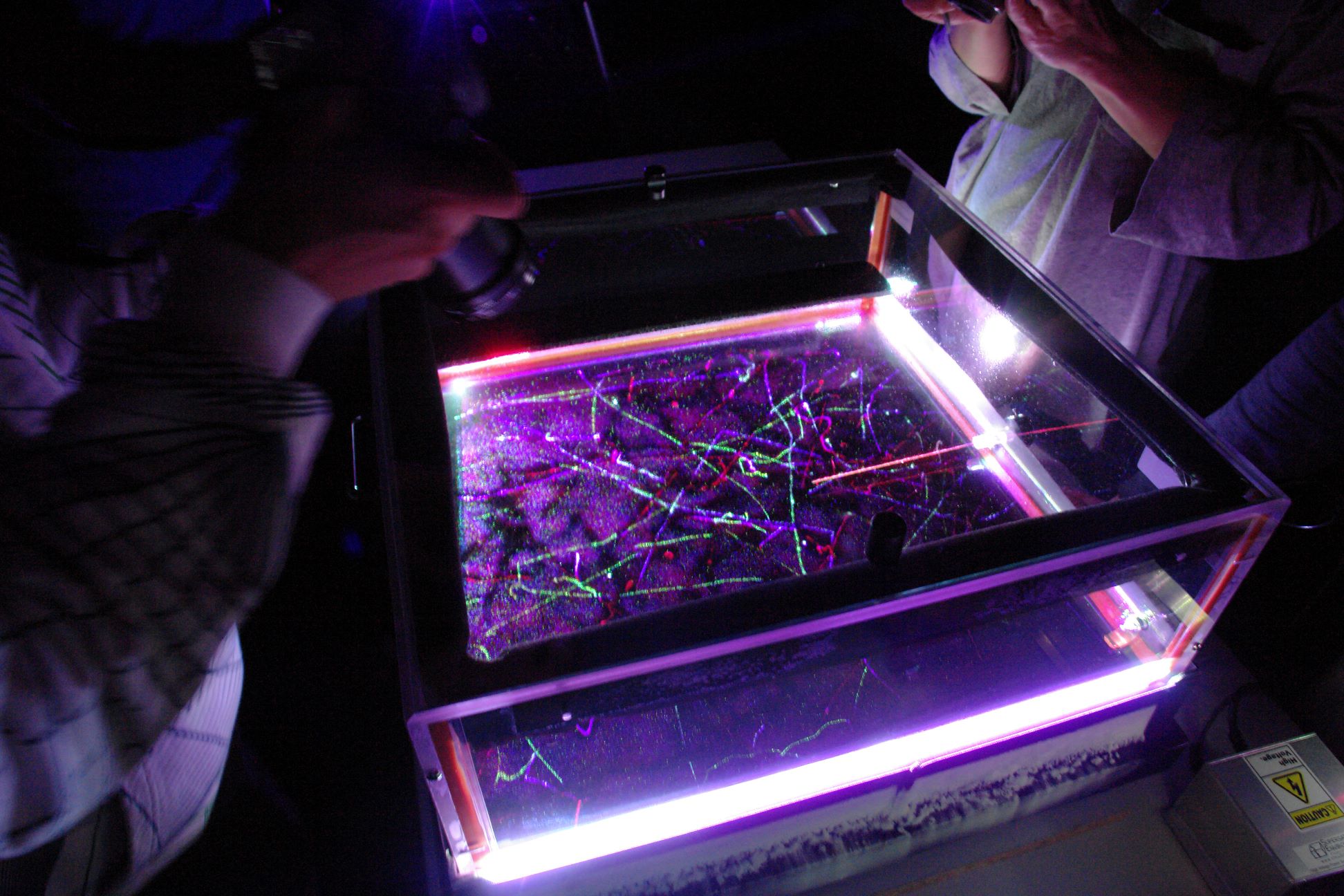
Memory Vapour, 2011, E. Domnitch and D. Gelfand.
In a dialogue with particle physics by Evelina Domnitch and Dmitry Gelfand.
Evelina Domnitch and Dmitry Gelfand website.
More about the work on the artists' website.
Secret Sound Stories
More than a walking catalogue, Secret Sound Stories bridges the experience of the visitor to the intents of the conceivers with real-life anecdotes putting the issue of fairness squarely in the individual experience of all.
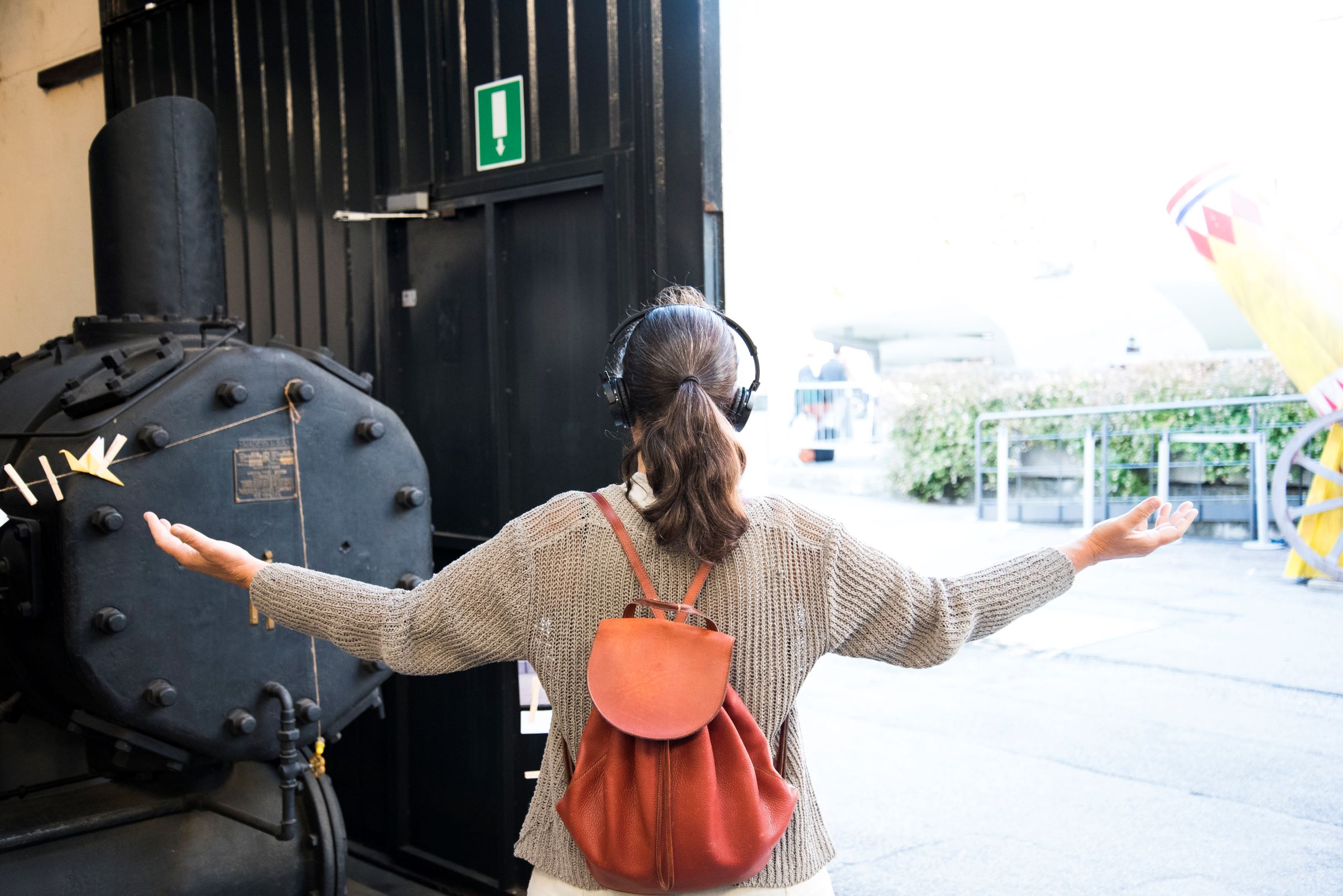
Secret Sound Stories, 2017, A. Alpenfelt.
Performance developed by Alan Alpenfelt in collaboration with philosopher Nicole Dewandre.
Alan Alpenfelt website.
More about the work on the artist's website.
